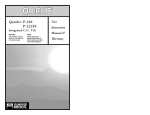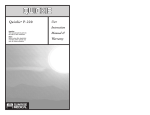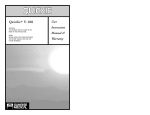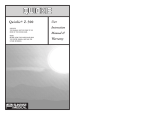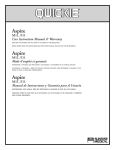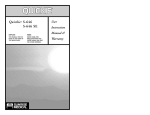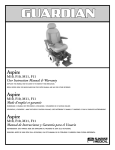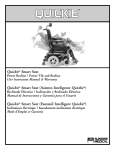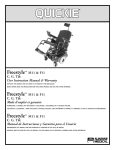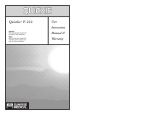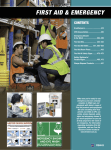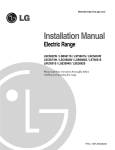Download Sunrise Medical Quickie S-646 User's Manual
Transcript
Quickie S-646 Integrated C.G. Tilt User SUPPLIER: THIS MANUAL MUST BE GIVEN TO THE RIDER OF THIS WHEELCHAIR. Manual RIDER: BEFORE USING THIS WHEELCHAIR READ THIS ENTIRE MANUAL AND SAVE FOR FUTURE REFERENCE. Supplement ® Instruction I. 2 Introduction Note INTRODUCTION NOTE– This supplement contains information on the operation and adjustments for the Integrated C.G.Tilt System of a Quickie S-646 wheelchair ONLY. Please refer to the Quickie S-646 User Instruction Manual for additional notices, EMI information, warnings, tips for attendants, set-up, adjustment and use information, operating guide, battery and maintenance information, wiring diagrams, and warranty information regarding the Quickie S-646. Sunrise Medical Customer Service Department 7477 East Dry Creek Parkway Longmont, Colorado 80503 (303) 218-4500 or (800) 333-4000 II. Ta b l e of Contents 3 I. INTRODUCTION NOTE............................................................................. 2 II. TABLE OF CONTENTS.............................................................................. 3 III.YOUR CHAIR AND ITS PARTS...................................................................... 4 IV. WARNINGS ........................................................................................... A. Solid Seat Back ................................................................................. B. Driving............................................................................................. C. Tilting ............................................................................................. 6 6 6 6 V. SET UP, ADJUSTMENT & USE................................................................... A. Battery Removal ................................................................................ B. Solid Seat Back & Lateral Thoracic Supports .......................................... C. Headrest .......................................................................................... D. Foam Back........................................................................................ E. Seat Tilt Adjustments ......................................................................... F. TM40 Single or Dual Switch Actuator Controller...................................... G. Articulating Ventilator Tray ................................................................. H. TM40 Single or Dual Switch Actuator Controller...................................... I. Check Out......................................................................................... 7 7 7 8 9 9 10 10 12 12 VI. OPERATING GUIDE ................................................................................ A. Toggle Switch Activation .................................................................... B. Single Switch Activation..................................................................... C. Remote Joystick Activation ................................................................. D. Specialty Drive Controls...................................................................... 13 13 13 13 13 VII. MAINTENANCE & TROUBLESHOOTING TIPS ............................................... 14 A. Maintenance ..................................................................................... 14 B. Troubleshooting Tips .......................................................................... 14 VIII. WIRING DIAGRAMS ............................................................................... 15 IX. SUNRISE LIMITED WARRANTY................................................................. 16 930576 Rev. A 930576 Rev. A III. 4 Yo u r Chair & Its Parts III. Yo u r Chair & Its Parts 5 QUICKIE S-646 INTEGRATED C.G. TILT 16 3 2 9 4 5 6 7 1 10 12 14 11 13 Quickie S-646 Integrated 1. Push Handle 2. Dual Post, Height-Adjustable Armrest 3. Remote Joystick 4. Jay Cushion (optional) 5. Swing-Away Footrest Latch Plate 6. Swing-Away Footrest Hanger 7. Heel Loop 8. Angle Adjustable Footplate 930576 Rev. A C.G. 9. Solid Seat Back 10. Battery Enclosure 11. 14" Drive Wheels 12. Caster Housing 13. 8" Solid Casters 14. Caster Fork 15. Tilt Toggle Switch (not shown) 16. Headrest Tilt 8 Weight 150 lb. With swing-away footrests and armrests, without batteries Drive Wheels 14" Mag Tire types: Standard - pneumatic Option - airless insert, solid Joystick Standard - remote (right-hand or left-hand mount) Option - swing-away retractable joystick Batteries (2 batteries required to operate chair) Option - GP 24 deep cycle gel, Option - 22 NF deep cycle gel Battery Charger Standard - off board (Lester) Colors Standard - blue, black, red, midnight purple, blue velvet, pearl pink, toxic green, forest green, burgundy, black opal, blue green, yellow, candy purple, candy teal, Optional: good vibrations, leopard, graphite Chair Parts Standard - black Seat Frame Dimensions Seat Frame width: standard - 14"24" Seat depth: 14"-22" adjustable Solid seat back Aluminum seat pan Optional cushions: Jay Cushions CG Tilt 3° - 53° 6° - 53° Backrest Standard - Non-folding: 15" - 20" Straight Backpost - standard Footrest Standard - Swing-away with angle adjustable footplates and heel loops. Option - elevating legrests, and multi-position Casters Standard - 8" solid Option - 8" pneumatic 9" pneumatic, solid Armrests Standard - dual post flip back Option - height-adjustable dual post or single post with desk or full length waterfall pads or standard armpads Wheel Locks Option - Push-to-lock Option - 6" extension handles Swing-Away Lateral Thoracic Supports Option - Curved Option - Straight Headrest Standard - 8" x 5" or 7" x 4.5" headrest pad All features may not be available with some chair setups or in conjunction with another chair feature. Please consult your supplier for more information. Your authorized supplier can also provide you with more information on accessories. 930576 Rev. A I V. 6 Wa r n i n g s A. SOLID SEAT BACK Do not use the Solid Seat back to push or lift the wheelchair. Improper use may cause the back to unexpectedly detach from the wheelchair. B. DRIVING You should drive your chair with the tilt at the minimum angle. However, if necessary the chair can be driven with the tilt at an angle of no greater than 15°. C. TILTING V. Set-up, Adjustment & Use 7 TOOLS YOU WILL NEED Basic Tool Kit: To set-up, adjust and maintain your chair you will need the following tools: • 5/32" Allen wrench • 3/16" Allen wrench • 5/16" Allen wrench • 9/16" box and open-end wrench • Phillips screwdriver #1 • Standard slot screwdriver A NOTE– Setting the wheelchair on a flat surface, such as a table or a workbench, helps make these procedures easier. A. BATTERY REMOVAL To prevent damage and personal injury, avoid tilting near objects such as walls, tables or chairs. To avoid injury, ensure other people, especially children, are clear of the system. If using a swing-away abductor, be sure not to tilt with the abductor swung away. Otherwise, the abductor may collide with the tilt actuator when returning the untilted position. D. CHANGES & ADJUSTMENTS Never use non-Quickie parts or make changes to your chair unless authorized by Sunrise. (Doing so will void the warranty and may create a safety hazard.) 1. If you modify or adjust this chair it may increase the risk of fall or tip-over. 2. Modifications unauthorized by Sunrise constitutes remanufacturing of the wheelchair. This voids the warranty. The rider then assumes all future liability for the wheelchair. To remove batteries for transport or service: 1. Unlatch both the right and left battery box rear cover retaining fasteners (A) by flipping back both latches and rotating one half turn. 2. Lower battery box rear cover (B) until the cover is fully extended and supported by the cables (C). 3. Disconnect the battery harness cables. 4. Slide out battery tray using handle. 5. Remove batteries (D). Batteries may weigh up to 55 lbs. Care must be taken to avoid injury when lifting. D C A B B. SOLID SEAT BACK & LATERAL THORACIC SUPPORTS 1. To adjust the height of the lateral support mount, loosen the adjustment screw until the receiver slides freely on the back posts. Tighten the adjustment screw when the proper height is determined. 2. Assess and fit the lateral thoracic supports. Assess client for proper positioning of the lateral thoracic supports. Each support is independent and may be adjusted for your client’s clinical need. A minimum of 1" (2.5 cm) of clearance should exist between the top of the lateral support and the user’s arm pit. 930576 Rev. A 930576 Rev. A V. 8 Set-up, Adjustment & a) To adjust the height, angle, or width of the lateral thoracic support pads, loosen the top bolts and slide to correct width. Tighten bolt to bolt plate. If more adjustment is necessary, loosen the internally mounted bolts, and slide in the track to the desired height and width. The angle is obtained by tilting the bracket as needed. Tighten the bolts. b) To adjust the depth of the lateral thoracic pads, turn the middle bracket so that the slots are on side. Adjust to desired depth. Retighten the bolts. Adjustment & Use 9 To secure the back foam and cover on the Solid Seat Back, slide the top edge of the cover over the top lip of the shell. Press the back in place against the shell. E. SEAT TILT ADJUSTMENTS 1. Initial Tilt Angle The upright angle can be adjusted to suit the rider. a) Operate the tilt system until the seat is tilted about 30°. b) Adjust the stop pin (A) to the desired positions. The stop pin lock-nuts (B) determine the resting position of the seat. When coming to a rest, the seat should contact both pins simultaneously. c) Tighten the stop pin lock-nuts. d) Raise the seat up once again. e) Remove the access cover on the actuator housing (C). f) Position the most rearward limit switch (D) such that the actuator shuts down when the seat contacts the stop pins (A). A NOTE– Do not loosen the screw any more than is necessary to slide the limit switch in its track. If the screw is over loosened, it may come out and be difficult to replace. B NOTE– Angle, front-to-back distance and left-to-right position are adjustable in this step. 930576 Rev. A Set-up, Secure the foam and cover to the shell. 1. Mounting a headrest. The Solid Seat Back has a universal headrest plate mounted to it. Care should be taken to use the proper screw length when mounting. c) Use the 3/16" Allen wrench to tighten the three (3) socket head cap screws on the upper pivot bracket (B). 4. Adjusting the position of the headrest pad. a) Use the 5/32" Allen wrench to loosen the three (3) socket head cap screws at the base of the headrest (C). b) Adjust the headrest to the desired position. Note: Ball and socket can be moved for rotational headrest adjustment in this step. c) Use the 5/32" Allen wrench to tighten the three (3) socket head cap screws at the base of the headrest (C). V. D. FOAM BACK C. HEADREST 2. Adjusting the height of the headrest. a) Loosen the hand lever handle (A). b) Raise or lower the headrest to the desired height. c) Tighten the hand lever handle (A). 3. Adjusting the position of the headrest mount. a) Use the 3/16" Allen wrench to loosen the three (3) socket head cap screws on the upper pivot bracket (B). b) Adjust the headrest position. Use C A B C E D NOTE– The limit switch adjustment should not allow the motor to stall as the seat frame contacts the stop pins. 2. Drive Lock-out Angle The drive lock-out angle is adjustable a) Tilt the seat back at least 30°. b) Remove the access cover on the actuator. c) Adjust the middle limit switch (E) until the desired lock-out position is achieved. d) Replace the access cover on the actuator housing (C). NOTE– The drive lock-out should be set such that the chair cannot be driven with the seat tilted to an angle of greater than 15°. 930576 Rev. A V. 10 Set-up, Adjustment F. ANTI-TIP CASTER LOCK-OUT 1. The rear anti-tip casters incorporate a lock-out mechanism to prevent the chair from sagging rearward when tilting. To adjust the tilt angle at which they lock-out follow the instructions below: a) Adjust the height of the anti-tip lock-out actuator levers (A). b) Adjust the cable position (B) at the anti-tip mount and the anti-tip lock-out actuator lever mount brackets (C). 2. Proper adjustment of the anti-tip lock-out levers can be verified when three conditions exist: a) The anti-tip lock-out levers under the anti-tip lower links are retracted when the seat frame is on the forward stops. b) The anti-tip lock-out levers (A) located at the front stop pins (D) do not rotate to the point that they can not be engaged by the seat frame forward cross tube when the seat frame is lowered toward the forward stop pins. c) When the seat frame is elevated off the antitip lock-out actuator levers (A), the anti-tip lock-out levers are free to engage the antitip lower links. & Use D B A C 930576 Rev. A Set-up, Adjustment & Use e) Fasten the split clamps (F) such that the clamps capture both the towel bar (C) and the swing-arm cross member. f) Rotate the position of the swing-arm cross member underneath the towel bar and as close to the seat back as possible. g) Tighten the split clamps (F). Do not fully tighten. Clamps should be tight so that the clamp does not rotate, except with sufficient hand force. h) Ensure that the lower four links (G) are positioned such that the upper portion of the links are slanted rearward beyond the vertical, as shown in the accompanying figure. i) Begin tilting the system. If the vent tray binds, or interferes with the battery box, return the tilt to an upright position and rotate the clamps around. Tilt the system once again and observe what happens. You may need to go through several iterations of clamp position before finding the most appropriate clamp location. You will know when you have achieved the appropriate position when the vent tray articulates just past the vent battery box when tilting and tucks up close to the back rest when fully upright. 11 Angle should be as small as possible Links should be slanted rearward NOTE– It is important to keep the angle between the swing-arm (E) and the vent tray platform (D) as small as possible. This will prevent the system from inadvertently binding due to vibration or impact. G. ARTICULATING VENTILATOR TRAY 1. Attach the Vent Tray to the S-646 Frame a) Slip the vent tray battery cage (A) over the rear frame tube of the S-646 (B). b) Fasten the battery cage to the frame using the two bolts provided. 2. Attach Vent Tray Swing-Arm to the Towel Bar. a) Position the Power C.G. Tilt system in the fully upright position. b) Adjust the towel bar (C) to the desired height. c) Position the vent tray platform (D) such that it is level with the floor and within 1.5" of the seat back. d) Adjust the length of the vent tray swing-arm (E) such that the swing-arm cross member is virtually at the same position as the towel bar. V. C F A E D B G 930576 Rev. A V. 12 Set-up, Adjustment & Use VI. Operating Guide 13 A. TOGGLE SWITCH ACTIVATION E A B D Stereo Jack F H G QTRONIX Power Module H. TM40 SINGLE OR DUAL SWITCH ACTUATOR CONTROLLER The TM40 actuator controller can be used to activate the tilt mechanism with either single or dual switch controls. 1. To operate, pull the toggle switch (A) back toward rider (to tilt back) or push toggle forward away from rider (to return to neutral) until tilted into the desired position. 2. The toggle switch will return to neutral when released and the seating system will stop moving. A B. SINGLE SWITCH ACTIVATION 1. Depress and hold single switch to tilt back into the desired position. 2. Depress and hold single switch to return to neutral until tilted into the desired position. C. REMOTE JOYSTICK ACTIVATION (OPTIONAL) From the “off” position 1. Push the on/off mode select toggle switch (A) down once to turn the chair “on”. 2. Push the on/off mode select toggle switch (A) up twice to move index to tilt mode (noted by two (2) actuator lights (B). 3. Push the joystick (C) either forward or backward until tilted into the desired position. 4. Push the on/off mode select toggle switch (A) up once to return to drive mode. C B A D. SPECIALTY DRIVE CONTROLS 1. Plug limit switch harness assembly (A) into TM40 limit switch jack (B). 2. Plug single switch (C) into TM40 single switch jack (D) OR plug dual switch (E) into TM40 dual switch jack (F). 3. Plug TM40 into the QTRONIX Power Module (G). 4. Use mating plugs (H) to connect the TM40 to the tilt actuator. I. CHECK-OUT Once the tilt assembly is adjusted, it should actuate smoothly and easily. All accessories should also perform smoothly. 1. Verify seat can achieve full tilt and will return to neutral. 2. Verify that the seat frame stops engage the stop pin cushions. 3. Verify the motor cuts out once the neutral position is reached. 4. Verify no debris is interfering with the glide bearings. 5. Verify all hardware is securely tightened. 930576 Rev. A Please refer to your QTRONIX USCM User Instruction Manual CAUTION– The tilt lock-out feature will activate and the chair will not tilt on slopes steeper than 6 degrees. CAUTION– The power base drive lock-out feature will activate and the chair cannot be driven if the seating system is tilted more than 15°. 930576 Rev. A VII. 14 Maintenance & Tr o u b l e s h o o t i n g VIII. Wiring Diagrams 15 TM40 Actuator Controller (Independent Switch Control) A. MAINTENANCE You should check the items on this chart at the indicated intervals. If any of the items are loose, worn, bent or distorted, immediately have them checked and/or repaired by your authorized Sunrise supplier. Frequent maintenance and servicing will improve performance and extend wheelchair life. NOTE– Check weekly, and use a clean, dry cloth or compressed air as needed to keep glide bearings free of debris. An al ly y ly rly th te nu ar on kl ✓ Glide bearings free of debris ✓ Check tires for proper inflation level ✓ Check batteries for proper electrolyte level (wet cell only) ✓ Check plugs and connectors for proper connections Qu M ily Charge Batteries ee W Da CHECK... ✓ Check all moving parts for wear ✓ Inspect all nuts, bolts and fasteners for looseness or wear ✓ Inspect upholstery for wear ✓ Remove and inspect motor brushes ✓ Servicing by authorized Supplier ALM Actuator Controller (Integrated Control) ✓ B. TROUBLESHOOTING TIPS If you should notice your C.G. Tilt system binding up, not running in a smooth fashion, or emitting an unusual noise during use, a foreign matter may have come into contact with the glide bearings. If this occurs, use a clean, dry cloth or compressed air to clear or, if needed, please see your authorized Sunrise supplier. If your tilt system will not function, check to ensure the tilt lock out sensor is seated properly in its mount. The wires should lead out of the sensor toward the front of the chair. Power Module 930576 Rev. A 930576 Rev. A 16 IX. Sunrise Limited Wa r r a n t y FOR THREE (3) YEARS: We warrant the C.G. power tilt seating system seat frame, sub-base frame, actuator and structural components of this wheelchair against defects in materials and workmanship for three (3) years from the date of first consumer purchase. FOR TWO (2) YEARS: We warrant the ALM (Actuator Lights Module) actuator controller for two (2) years from the date of first consumer purchase. FOR ONE (1) YEAR: We warrant other electronic components such as the single switch actuator controller for one (1) year from the date of the first consumer purchase. ADDITIONAL WARRANTY: We warrant all other original components (such as upholstery, plastic, rubber parts and painted surfaces) for three (3) months from the date of first consumer purchase. Sunrise Medical 7477 East Dry Creek Parkway Longmont, Colorado • 80503 USA (800) 333-4000 In Canada (800) 263-3390 © 2002, Sunrise Medical 8.02 930576 Rev A











